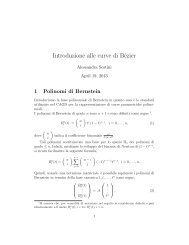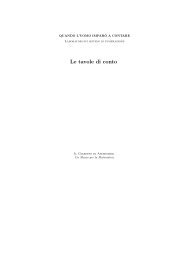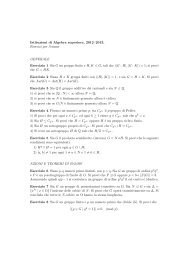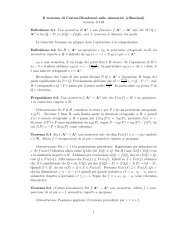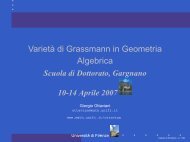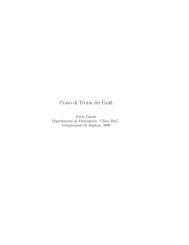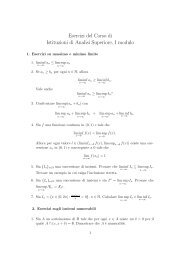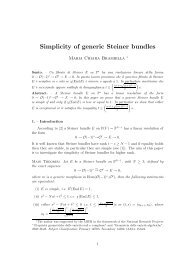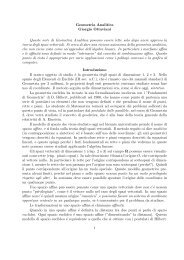Tesi di Laurea di Valentina Boccini - Dipartimento di Matematica e ...
Tesi di Laurea di Valentina Boccini - Dipartimento di Matematica e ...
Tesi di Laurea di Valentina Boccini - Dipartimento di Matematica e ...
You also want an ePaper? Increase the reach of your titles
YUMPU automatically turns print PDFs into web optimized ePapers that Google loves.
CAPITOLO 3. COMPLEMENTI AL TEOREMA DI BARNING 85<br />
osserviamo che:<br />
Se (x, y) ∈ Q ∩ Q 2 :<br />
(x, y) =<br />
T |Q∩Q 2 = B ◦ S ◦ B −1 .<br />
<br />
a b B−1 , → (a, b, c)<br />
c c<br />
S → S(a, b, c) B <br />
a b<br />
→ T , = T (x, y).<br />
c c<br />
Quin<strong>di</strong>, poiché ad un certo passo (n + 1) abbiamo che S n+1 è uguale a<br />
(1, 0, 1) o a (0, 1, 1), allora T n+1 sarà uguale a (1, 0) o a (0, 1).<br />
Ve<strong>di</strong>amo adesso che, sempre se siamo nel caso <strong>di</strong> coor<strong>di</strong>nate razionali, la<br />
funzione d determina, per come è stata definita, proprio il giusto sviluppo<br />
della terna corrispondente.<br />
Consideriamo una terna<br />
(a, b, c) ∈ P P T ;<br />
<br />
a b<br />
, = (x, y) ∈ Q ∩ Q<br />
c c<br />
2 .<br />
La prima cifra dello sviluppo <strong>di</strong> (a, b, c) è uguale ad 1 se e solo se<br />
−a − 2b + 2c < 0<br />
−2a − b + 2c > 0 ⇔<br />
−x − 2y + 2 < 0<br />
−2x − y + 2 > 0<br />
L’intersezione dei due semipiani e dell’arco Q coincide proprio con la parte<br />
<strong>di</strong> Q delimitata da <br />
3 4 , e (0, 1), estremi esclusi.<br />
5 5<br />
Questo arco aperto coincide anche con l’intersezione tra Q ed il semipiano<br />
{ x<br />
y<br />
< 3<br />
4 }.<br />
Quin<strong>di</strong><br />
d1 = 1 ⇔ x<br />
y<br />
Analogamente si verifica che<br />
d1 = 2 ⇔ 3<br />
4<br />
d1 = 3 ⇔ 4<br />
3<br />
< x<br />
y<br />
< 3<br />
4<br />
< x<br />
y<br />
< 4<br />
3<br />
⇔ d(x, y) = 1.<br />
⇔ d(x, y) = 2;<br />
⇔ d(x, y) = 3.<br />
Continuando la verifica per induzione, <strong>di</strong>mostriamo il primo punto.<br />
Mostriamo che, se (x ′ , y ′ ) = T (x, y) ∈ Q 2 , allora anche (x, y) ∈ Q 2 .<br />
Supponiamo che<br />
a ′<br />
b′<br />
,<br />
c ′ c ′<br />
<br />
= (x ′ , y ′ ) = T (x, y).




